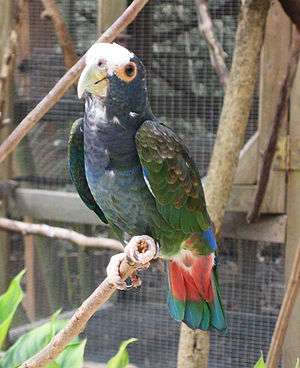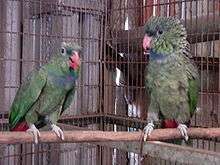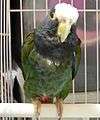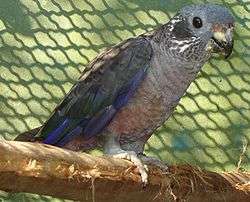Pionus
| Pionus | |
|---|---|
 | |
| White-crowned parrot, Pionus senilis, at Macaw Mountain Bird Park, Honduras | |
| Scientific classification | |
| Kingdom: | Animalia |
| Phylum: | Chordata |
| Class: | Aves |
| Order: | Psittaciformes |
| Superfamily: | Psittacoidea |
| Family: | Psittacidae |
| Subfamily: | Arinae |
| Tribe: | Androglossini |
| Genus: | Pionus Wagler, 1832 |
| Species | |
|
7-10, see text | |
Pionus is a genus of medium-sized parrots native to Mexico, and Central and South America. Characteristic of the genus are the chunky body, bare eye ring (which can vary in color), and short square tail. They are superficially similar to Amazon parrots, but smaller and in flight their wing-strokes are far deeper. Coloration is generally subdued yet complex; under bright lighting, their feathers shimmer with iridescent brilliance. All species share bright red undertail coverts; the scientific name of one species, the blue-headed parrot (P. menstruus), refers to this. Males and females are similar, with no notable sexual dimorphism.
Taxonomy
The speckle-faced parrot is often split into two species, while a small number of authorities have suggested the blue-headed parrot should be split into two or three species.
- Blue-headed parrot (or blue-headed pionus), Pionus menstruus
- Paler blue-headed parrot (or paler blue-headed pionus), Pionus (menstruus) rubrigularis
- Reichenow's blue-headed parrot (or Reichenow's blue-headed pionus), Pionus (menstruus) reichenowi
- Red-billed parrot (or red-billed pionus, coral-billed parrot, coral-billed pionus), Pionus sordidus
- Scaly-headed parrot (or scaly-headed pionus, Maximilian's pionus, Maximilian's parrot), Pionus maximiliani
- White-crowned parrot (or white-crowned pionus), Pionus senilis
- Speckle-faced parrot (or speckle-faced pionus), Pionus tumultuosus
- Plum-crowned parrot (or plum-crowned pionus), Pionus (tumultuosus) tumultuosus
- White-capped parrot (or white-headed pionus), Pionus seniloides
- Bronze-winged parrot (or bronze-winged pionus), Pionus chalcopterus
- Dusky parrot (or dusky pionus), Pionus fuscus
Pets
Pionus parrots are regarded as excellent pets, although some species are very rare in captivity. Most commonly kept species are the Blue-headed, Maximillian (Scaly-headed) and White-capped. Others, such as the Dusky and the Bronze-winged have become more common due to captive breeding.
Pionus parrots are quieter than Amazon parrots.[1] Unlike some other companion parrots, aviculturists have noted that they are not particularly energetic, and do not generally enjoy hands-on play (for example, being flipped on their backs), but they do provide companionship and are described as gentle and charming pets.
When excited or frightened, birds of this genus emit a characteristic wheezing or snorting sound that is sometimes mistaken for a sign of distress, or a symptom of disease. They also give off a musky or sweet odor that some caretakers find unpleasant, but others enjoy.
Health
Pionus parrots are susceptible to obesity, vitamin A deficiency, and aspergillosis in captivity. These conditions, with the exception of aspergillosis, are easily prevented.
Diet
As a species, the Pionus naturally eats mostly fruits, especially guavas. Pet owners should take care to not feed their bird any high-fat foods. Pet stores often carry banana chips (which are good snacks for many other birds) that are fried in oil to make them crispy, but they contain too much fat for the Pionus and could result in high cholesterol or other health issues related to too much fat intake.[2]
Pionus owners should consult a knowledgeable veterinarian (preferably a South American exotic bird expert) on proper Pionus dietary needs.
Species
| Species | |||
|---|---|---|---|
| Common and binomial names | Image | Description | Range |
| Blue-headed parrot (Pionus menstruus) |
Mostly green, blue head and neck (also underparts in subspecies reichenowi). Red undertail coverts | tropical South and Central America | |
| Red-billed parrot (Pionus sordidus) |
 |
Mostly green, chest dull blue, bill bright red. Red undertail coverts |
north-western South America |
| Scaly-headed parrot (Pionus maximiliani) |
Primarily green head feathers that are edged in a royal blue. The chest can be anywhere from royal blue to indigo in color. Wings and back are mainly green, some birdsmay develop bronze 'epilets' on their shoulders. Red undertail/vent area. Feather in this area are tipped with a light green and in some cases aqua or violet. The beak is anywhere from black to horn in color, most birds having a two-tone beak. Skin is usually grey to pink. | eastern and central South America | |
| White-crowned parrot (Pionus senilis) |
 |
Mostly dark green and dark blue. White forehead and crown and whitish throat. Olive shoulder patch. Light green belly. Red undertail coverts. Males and females may have a pinkish eye ring. | Mexico and Central America |
| Speckle-faced parrot (Pionus tumultuosus) |
 |
Mostly green with dull bluish-grey neck and red undertail coverts. Head speckled red (nominate subspecies) or white (subspecies seniloides) | Andes in South America |
| Bronze-winged parrot (Pionus chalcopterus) |
.jpg) |
Mostly dark blue with red undertail coverts. Wings dark bronze-green and throat pinkish. | north-western South America |
| Dusky parrot (Pionus fuscus) |
 |
Mostly dark brownish-grey, flight feathers blue and undertail coverts red | north-eastern South America |
References
- ↑ Alderton, David (2003). The Ultimate Encyclopedia of Caged and Aviary Birds. London, England: Hermes House. p. 228. ISBN 1-84309-164-X.
- ↑ Stanford, Michael BVSc, MRCVS (2005). "Significance of Cholesterol Assays in the Investigation of Hepatic Lipidosis and Atherosclerosis in Psittacine Birds" (PDF). ICE2005 PROCEEDINGS. www.exoticdvm.com. Retrieved 2013-02-23.